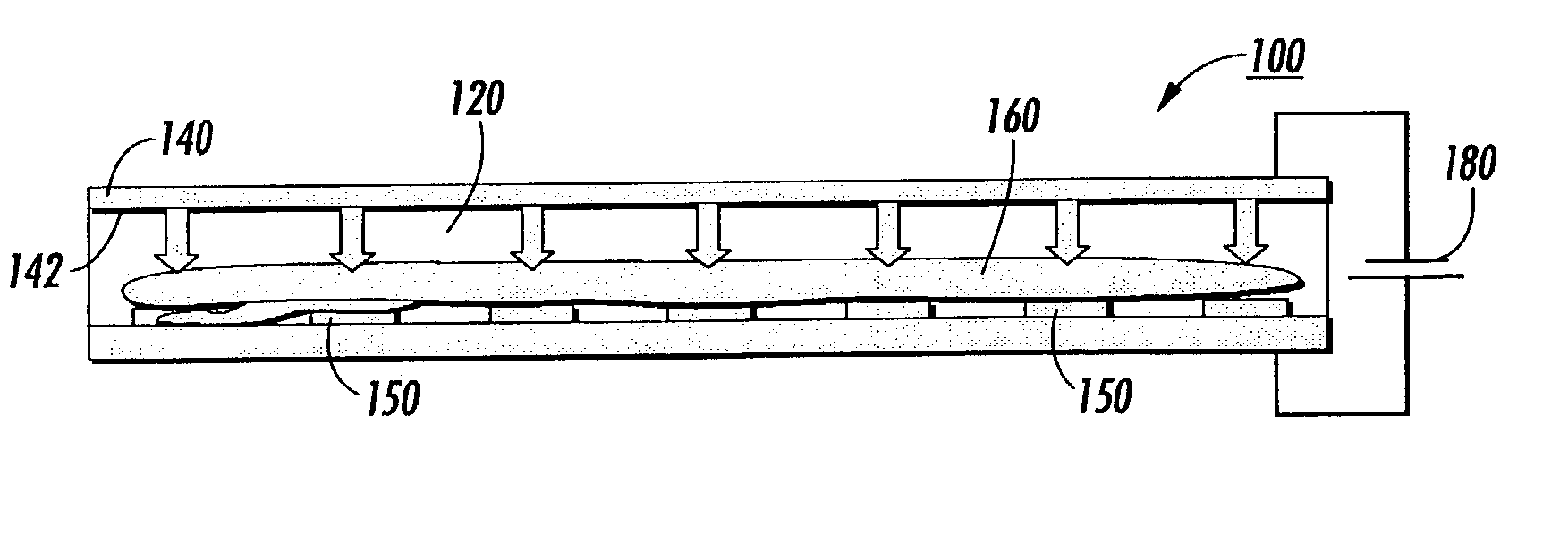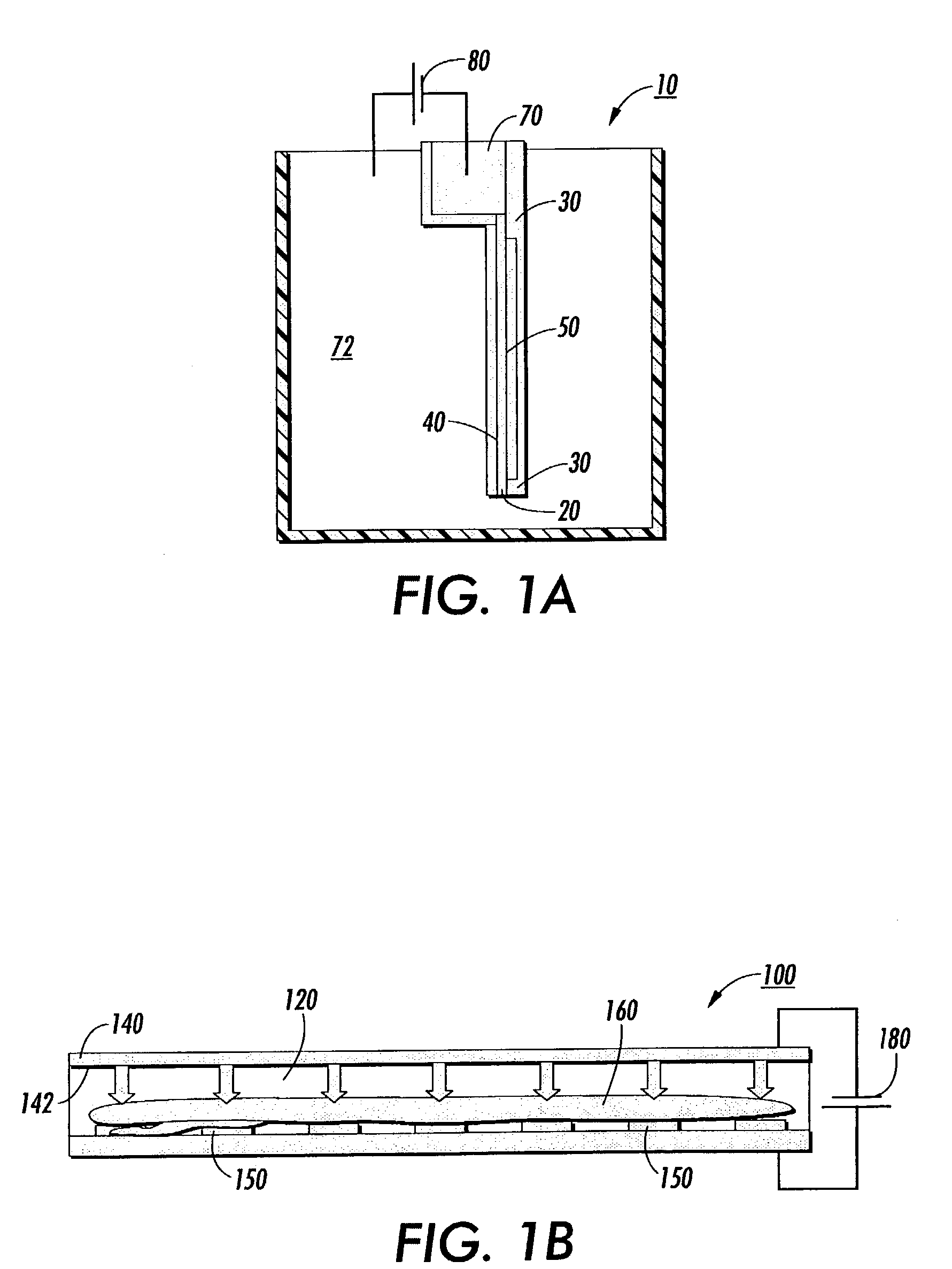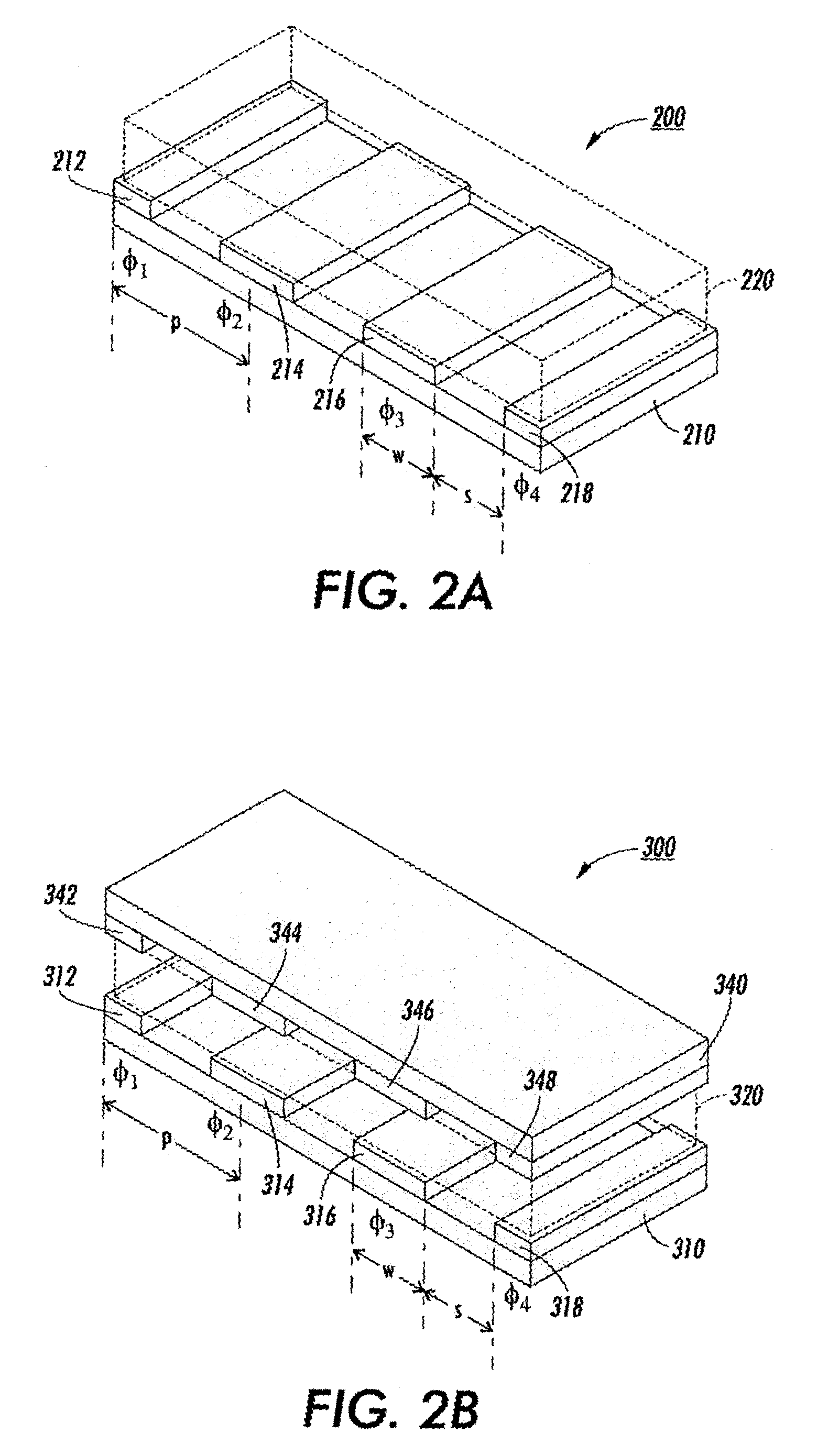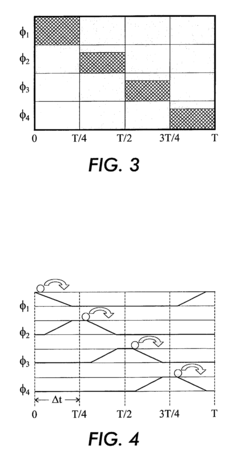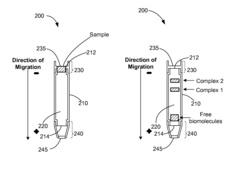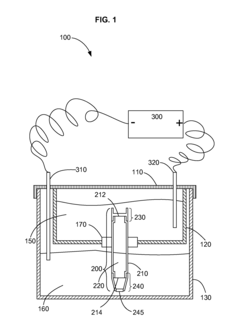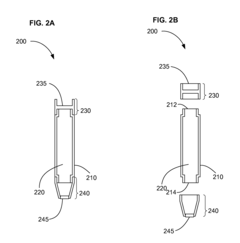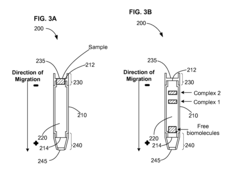Gel Electrophoresis: Bridging Gaps in Evolutionary Biology
JUN 30, 20259 MIN READ
Generate Your Research Report Instantly with AI Agent
Patsnap Eureka helps you evaluate technical feasibility & market potential.
Gel Electrophoresis Evolution and Objectives
Gel electrophoresis has been a cornerstone technique in molecular biology since its inception in the 1960s. This method, which separates molecules based on their size and electrical charge, has undergone significant evolution over the decades, playing a crucial role in advancing our understanding of evolutionary biology.
The technique's development can be traced back to the work of Arne Tiselius in the 1930s, who first demonstrated the separation of proteins using electrophoresis. However, it was not until the 1950s and 1960s that gel-based electrophoresis methods were developed, providing a more stable medium for molecule separation.
In the context of evolutionary biology, gel electrophoresis has been instrumental in analyzing DNA, RNA, and proteins, allowing researchers to compare genetic material across species and track evolutionary changes. The technique's ability to separate DNA fragments of different sizes has been particularly valuable in studying genetic variations and mutations that drive evolutionary processes.
The objectives of gel electrophoresis in evolutionary biology have expanded over time. Initially, it was primarily used for DNA fingerprinting and restriction fragment length polymorphism (RFLP) analysis. These applications allowed scientists to identify genetic differences between individuals and species, providing insights into evolutionary relationships and population genetics.
As the field progressed, gel electrophoresis became a key tool in genome mapping and sequencing projects. The Human Genome Project, for instance, relied heavily on gel electrophoresis techniques to separate and analyze DNA fragments. This application has been extended to studying the genomes of various organisms, contributing significantly to our understanding of evolutionary history and mechanisms.
In recent years, the objectives of gel electrophoresis in evolutionary biology have further diversified. The technique is now used in conjunction with advanced molecular methods such as PCR and DNA sequencing to study ancient DNA, track the evolution of pathogens, and investigate the genetic basis of adaptation in various species.
Looking forward, the evolution of gel electrophoresis continues with the development of more sophisticated variants such as pulsed-field gel electrophoresis (PFGE) and capillary electrophoresis. These advancements aim to improve resolution, speed, and the ability to analyze larger DNA fragments, further enhancing our capacity to explore evolutionary questions at the molecular level.
The ongoing objectives for gel electrophoresis in evolutionary biology include increasing sensitivity to detect minor genetic variations, improving automation for high-throughput analysis, and integrating with other cutting-edge technologies such as next-generation sequencing and bioinformatics. These developments promise to bridge even more gaps in our understanding of evolutionary processes, from the molecular to the organismal level.
The technique's development can be traced back to the work of Arne Tiselius in the 1930s, who first demonstrated the separation of proteins using electrophoresis. However, it was not until the 1950s and 1960s that gel-based electrophoresis methods were developed, providing a more stable medium for molecule separation.
In the context of evolutionary biology, gel electrophoresis has been instrumental in analyzing DNA, RNA, and proteins, allowing researchers to compare genetic material across species and track evolutionary changes. The technique's ability to separate DNA fragments of different sizes has been particularly valuable in studying genetic variations and mutations that drive evolutionary processes.
The objectives of gel electrophoresis in evolutionary biology have expanded over time. Initially, it was primarily used for DNA fingerprinting and restriction fragment length polymorphism (RFLP) analysis. These applications allowed scientists to identify genetic differences between individuals and species, providing insights into evolutionary relationships and population genetics.
As the field progressed, gel electrophoresis became a key tool in genome mapping and sequencing projects. The Human Genome Project, for instance, relied heavily on gel electrophoresis techniques to separate and analyze DNA fragments. This application has been extended to studying the genomes of various organisms, contributing significantly to our understanding of evolutionary history and mechanisms.
In recent years, the objectives of gel electrophoresis in evolutionary biology have further diversified. The technique is now used in conjunction with advanced molecular methods such as PCR and DNA sequencing to study ancient DNA, track the evolution of pathogens, and investigate the genetic basis of adaptation in various species.
Looking forward, the evolution of gel electrophoresis continues with the development of more sophisticated variants such as pulsed-field gel electrophoresis (PFGE) and capillary electrophoresis. These advancements aim to improve resolution, speed, and the ability to analyze larger DNA fragments, further enhancing our capacity to explore evolutionary questions at the molecular level.
The ongoing objectives for gel electrophoresis in evolutionary biology include increasing sensitivity to detect minor genetic variations, improving automation for high-throughput analysis, and integrating with other cutting-edge technologies such as next-generation sequencing and bioinformatics. These developments promise to bridge even more gaps in our understanding of evolutionary processes, from the molecular to the organismal level.
Market Demand Analysis for Gel Electrophoresis in Evolutionary Biology
The market demand for gel electrophoresis in evolutionary biology has been steadily growing, driven by the increasing need for advanced molecular techniques in studying genetic diversity and evolutionary relationships. This technology plays a crucial role in various applications within the field, including DNA fingerprinting, genetic mapping, and phylogenetic analysis.
One of the primary factors fueling market growth is the rising interest in biodiversity conservation and the study of endangered species. Researchers and conservation biologists utilize gel electrophoresis to analyze genetic markers and assess population structures, helping to develop effective conservation strategies. This application has seen a significant uptick in demand, particularly in regions with high biodiversity hotspots.
The pharmaceutical and biotechnology sectors also contribute substantially to the market demand for gel electrophoresis in evolutionary biology. These industries rely on the technology for drug discovery processes, especially in the development of biopharmaceuticals and personalized medicine. The ability to analyze protein structures and interactions using gel electrophoresis techniques is invaluable in understanding evolutionary relationships and identifying potential drug targets.
Academic and research institutions represent another major segment driving market demand. Universities and research centers worldwide are expanding their molecular biology departments, leading to increased adoption of gel electrophoresis equipment and consumables. The technology's versatility in analyzing both nucleic acids and proteins makes it an essential tool in evolutionary biology research projects.
The market for gel electrophoresis in evolutionary biology is also benefiting from technological advancements. Innovations such as pulsed-field gel electrophoresis (PFGE) and capillary electrophoresis have expanded the range of applications and improved the resolution of genetic analyses. These developments have attracted researchers looking for more precise and efficient methods to study evolutionary processes at the molecular level.
Geographically, North America and Europe currently dominate the market due to their well-established research infrastructure and substantial funding for life sciences research. However, emerging economies in Asia-Pacific and Latin America are showing rapid growth in demand, driven by increasing investments in biotechnology and genomics research.
The COVID-19 pandemic has also indirectly boosted the market for gel electrophoresis in evolutionary biology. The global focus on understanding viral evolution and mutations has highlighted the importance of molecular techniques in tracking and analyzing genetic changes over time. This has led to increased funding and research activities in evolutionary biology, subsequently driving the demand for gel electrophoresis technologies.
One of the primary factors fueling market growth is the rising interest in biodiversity conservation and the study of endangered species. Researchers and conservation biologists utilize gel electrophoresis to analyze genetic markers and assess population structures, helping to develop effective conservation strategies. This application has seen a significant uptick in demand, particularly in regions with high biodiversity hotspots.
The pharmaceutical and biotechnology sectors also contribute substantially to the market demand for gel electrophoresis in evolutionary biology. These industries rely on the technology for drug discovery processes, especially in the development of biopharmaceuticals and personalized medicine. The ability to analyze protein structures and interactions using gel electrophoresis techniques is invaluable in understanding evolutionary relationships and identifying potential drug targets.
Academic and research institutions represent another major segment driving market demand. Universities and research centers worldwide are expanding their molecular biology departments, leading to increased adoption of gel electrophoresis equipment and consumables. The technology's versatility in analyzing both nucleic acids and proteins makes it an essential tool in evolutionary biology research projects.
The market for gel electrophoresis in evolutionary biology is also benefiting from technological advancements. Innovations such as pulsed-field gel electrophoresis (PFGE) and capillary electrophoresis have expanded the range of applications and improved the resolution of genetic analyses. These developments have attracted researchers looking for more precise and efficient methods to study evolutionary processes at the molecular level.
Geographically, North America and Europe currently dominate the market due to their well-established research infrastructure and substantial funding for life sciences research. However, emerging economies in Asia-Pacific and Latin America are showing rapid growth in demand, driven by increasing investments in biotechnology and genomics research.
The COVID-19 pandemic has also indirectly boosted the market for gel electrophoresis in evolutionary biology. The global focus on understanding viral evolution and mutations has highlighted the importance of molecular techniques in tracking and analyzing genetic changes over time. This has led to increased funding and research activities in evolutionary biology, subsequently driving the demand for gel electrophoresis technologies.
Current Challenges in Gel Electrophoresis Techniques
Gel electrophoresis, a cornerstone technique in molecular biology and evolutionary studies, faces several challenges that hinder its full potential in bridging gaps in evolutionary biology. One of the primary issues is the limited resolution for separating DNA fragments of similar sizes. Traditional agarose gels struggle to distinguish between fragments that differ by less than 10-20 base pairs, which can be crucial in detecting small genetic variations among closely related species.
Another significant challenge is the time-consuming nature of the technique. Conventional gel electrophoresis can take several hours to complete, which limits its applicability in high-throughput studies essential for large-scale evolutionary analyses. This time constraint becomes particularly problematic when dealing with time-sensitive samples or when rapid results are needed for immediate decision-making in research or diagnostic settings.
The reproducibility of gel electrophoresis results also presents a challenge. Variations in gel composition, running conditions, and even ambient temperature can lead to inconsistencies in band migration patterns. This variability can complicate the comparison of results across different experiments or laboratories, potentially leading to misinterpretations in evolutionary studies that rely on precise genetic comparisons.
Furthermore, the sensitivity of gel electrophoresis is often insufficient for detecting low-abundance DNA fragments. This limitation is particularly problematic in studies of ancient DNA or environmental samples where target sequences may be present in minute quantities. The inability to visualize these low-copy-number fragments can result in incomplete genetic profiles and potentially skewed evolutionary interpretations.
The quantitative analysis of DNA bands in gel electrophoresis also poses challenges. While software tools have improved the accuracy of band intensity measurements, factors such as background noise, non-uniform staining, and gel imperfections can still introduce errors. This imprecision can affect the reliability of quantitative comparisons, which are often crucial in evolutionary studies examining gene copy numbers or relative abundances of different genetic variants.
Lastly, the use of potentially harmful chemicals in gel electrophoresis raises safety and environmental concerns. Traditional DNA stains like ethidium bromide are mutagenic, necessitating careful handling and disposal. The search for safer alternatives has led to the development of new staining methods, but these often come with trade-offs in sensitivity or cost, presenting additional challenges for researchers in balancing safety, effectiveness, and budget constraints.
Another significant challenge is the time-consuming nature of the technique. Conventional gel electrophoresis can take several hours to complete, which limits its applicability in high-throughput studies essential for large-scale evolutionary analyses. This time constraint becomes particularly problematic when dealing with time-sensitive samples or when rapid results are needed for immediate decision-making in research or diagnostic settings.
The reproducibility of gel electrophoresis results also presents a challenge. Variations in gel composition, running conditions, and even ambient temperature can lead to inconsistencies in band migration patterns. This variability can complicate the comparison of results across different experiments or laboratories, potentially leading to misinterpretations in evolutionary studies that rely on precise genetic comparisons.
Furthermore, the sensitivity of gel electrophoresis is often insufficient for detecting low-abundance DNA fragments. This limitation is particularly problematic in studies of ancient DNA or environmental samples where target sequences may be present in minute quantities. The inability to visualize these low-copy-number fragments can result in incomplete genetic profiles and potentially skewed evolutionary interpretations.
The quantitative analysis of DNA bands in gel electrophoresis also poses challenges. While software tools have improved the accuracy of band intensity measurements, factors such as background noise, non-uniform staining, and gel imperfections can still introduce errors. This imprecision can affect the reliability of quantitative comparisons, which are often crucial in evolutionary studies examining gene copy numbers or relative abundances of different genetic variants.
Lastly, the use of potentially harmful chemicals in gel electrophoresis raises safety and environmental concerns. Traditional DNA stains like ethidium bromide are mutagenic, necessitating careful handling and disposal. The search for safer alternatives has led to the development of new staining methods, but these often come with trade-offs in sensitivity or cost, presenting additional challenges for researchers in balancing safety, effectiveness, and budget constraints.
Existing Gel Electrophoresis Solutions for Evolutionary Biology
01 Gel composition and preparation
Various gel compositions and preparation methods are used in gel electrophoresis. These include specific formulations of agarose, polyacrylamide, and other polymers to create gels with desired properties for different separation applications. The composition and preparation of the gel matrix are crucial for achieving optimal resolution and separation of molecules.- Gel composition and preparation: Various gel compositions and preparation methods are used in gel electrophoresis. These include specific formulations of agarose or polyacrylamide gels, as well as techniques for creating gradient gels. The composition and preparation of the gel matrix are crucial for achieving optimal separation of molecules based on size and charge.
- Electrophoresis apparatus design: Innovations in electrophoresis apparatus design focus on improving efficiency, resolution, and ease of use. These designs may include novel electrode configurations, buffer circulation systems, or temperature control mechanisms. Some apparatuses are designed for specific applications or to accommodate different gel formats.
- Detection and analysis methods: Various detection and analysis methods are employed in gel electrophoresis to visualize and quantify separated molecules. These may include fluorescence-based detection, colorimetric methods, or integration with mass spectrometry. Advanced image analysis techniques and software are also developed to interpret electrophoresis results accurately.
- Sample preparation and loading techniques: Innovations in sample preparation and loading techniques aim to improve the resolution and reproducibility of gel electrophoresis. These may include methods for concentrating samples, removing interfering substances, or novel ways to load samples onto the gel. Some techniques focus on minimizing sample volume or increasing the number of samples that can be analyzed simultaneously.
- Specialized electrophoresis applications: Gel electrophoresis techniques are adapted for specialized applications in various fields. These may include methods for separating specific types of molecules, such as proteins or nucleic acids, or techniques optimized for particular research areas like forensics or clinical diagnostics. Some applications focus on miniaturization or integration with other analytical techniques.
02 Electrophoresis apparatus design
Innovations in electrophoresis apparatus design focus on improving efficiency, reproducibility, and ease of use. These designs may include features such as integrated cooling systems, adjustable voltage controls, and specialized buffer chambers. Advanced apparatus designs aim to enhance separation quality and reduce run times.Expand Specific Solutions03 Detection and analysis methods
Various detection and analysis methods are employed in gel electrophoresis to visualize and quantify separated molecules. These may include fluorescence detection, colorimetric staining, or integration with mass spectrometry. Advanced imaging and data analysis techniques are developed to improve sensitivity and accuracy in interpreting electrophoresis results.Expand Specific Solutions04 Specialized electrophoresis techniques
Specialized electrophoresis techniques have been developed for specific applications or to improve separation of particular types of molecules. These may include pulsed-field gel electrophoresis, two-dimensional electrophoresis, or capillary electrophoresis. Such techniques often involve modifications to the gel composition, electric field application, or overall process to achieve better resolution or separation of complex mixtures.Expand Specific Solutions05 Sample preparation and loading
Innovations in sample preparation and loading techniques aim to improve the quality and reproducibility of gel electrophoresis results. These may include methods for concentrating samples, removing interfering substances, or applying samples to the gel in a precise and uniform manner. Advanced loading techniques can enhance resolution and prevent sample diffusion during the electrophoresis process.Expand Specific Solutions
Key Players in Gel Electrophoresis Industry
The gel electrophoresis market in evolutionary biology is in a growth phase, driven by increasing applications in genomics and proteomics research. The global market size is estimated to be in the hundreds of millions of dollars, with steady expansion projected. Technologically, gel electrophoresis is mature but continues to evolve with innovations in automation, resolution, and throughput. Key players like Bio-Rad Laboratories, Thermo Fisher Scientific (via Life Technologies), and Agilent Technologies dominate the market, offering advanced systems and consumables. Emerging companies such as Lumencor and Sage Science are introducing novel technologies to enhance performance and expand applications, indicating ongoing innovation in this established field.
Life Technologies Corp.
Technical Solution: Life Technologies, now part of Thermo Fisher Scientific, has made significant contributions to gel electrophoresis in evolutionary biology. Their E-Gel electrophoresis system uses pre-cast agarose gels with integrated ethidium bromide for quick and easy DNA separation and visualization[7]. The company's Novex gel systems offer high-resolution protein separation, crucial for comparative proteomics in evolutionary studies[8]. Life Technologies has also developed the iBind Western System, which automates the protein detection process after gel electrophoresis, improving consistency and reducing hands-on time[9]. Their digital imaging systems, such as the iBright Imaging Systems, provide sensitive detection and analysis of electrophoresis results, facilitating the study of genetic and protein variations across species[10].
Strengths: Comprehensive product line covering all aspects of gel electrophoresis workflow, from sample preparation to analysis. Weaknesses: Some proprietary systems may limit flexibility in experimental design.
Bio-Rad Laboratories, Inc.
Technical Solution: Bio-Rad has pioneered several innovations in gel electrophoresis for evolutionary biology research. Their CHEF-DR III System utilizes pulsed-field gel electrophoresis (PFGE) to separate large DNA molecules, crucial for studying genomic rearrangements in evolutionary studies[4]. Bio-Rad's Mini-PROTEAN precast gels offer consistent performance for protein separation, while their Criterion TGX Stain-Free precast gels provide rapid visualization of proteins without staining[5]. The company has also developed the NGC Chromatography Systems, which can be used in conjunction with gel electrophoresis for more comprehensive biomolecule analysis[6]. Bio-Rad's approach combines traditional gel electrophoresis techniques with modern automation and imaging technologies to enhance research in evolutionary biology.
Strengths: Wide range of products catering to various electrophoresis needs, from basic to advanced applications. Weaknesses: Some systems may have a steeper learning curve for new users.
Innovative Gel Electrophoresis Techniques for Phylogenetic Studies
Distributed multi-segmented reconfigurable traveling wave grids for separation of proteins in gel electrophoresis
PatentActiveUS7156970B2
Innovation
- The implementation of a gel electrophoretic system utilizing electrostatic traveling waves with embedded traveling wave grids on both sides of the gel, optimized for enhanced protein loading and transport, reduces processing time and band broadening, and improves resolution and reproducibility by creating higher field strengths with lower voltages.
Method for the purification of biological macromolecules
PatentInactiveUS20110011742A1
Innovation
- The method involves loading a sample containing free biomolecules and complexes onto an electrophoresis gel, applying an electric current to separate the free biomolecules from the complexes, and then reversing the current direction to collect the complexes of interest, using a semi-permeable membrane to retain the biomolecules of interest, thus masking inhomogeneity and concentrating them for analysis.
Bioinformatics Integration in Gel Electrophoresis Analysis
The integration of bioinformatics in gel electrophoresis analysis has revolutionized the field of evolutionary biology, providing researchers with powerful tools to extract, process, and interpret complex genetic data. This synergy between traditional laboratory techniques and advanced computational methods has significantly enhanced our ability to unravel evolutionary relationships and genetic diversity across species.
Bioinformatics software packages have been developed to automate and streamline the analysis of gel electrophoresis results. These tools can rapidly process large datasets, identify DNA fragments, and compare band patterns across multiple samples. Advanced algorithms can detect subtle variations in band intensity and position, allowing for more precise quantification of genetic differences between individuals or populations.
Machine learning approaches have been incorporated into gel electrophoresis analysis, enabling the identification of complex patterns and relationships that may not be apparent through traditional visual inspection. These techniques can classify samples based on their genetic profiles, predict evolutionary relationships, and even infer functional properties of genes based on their electrophoretic behavior.
Database integration has become a crucial aspect of bioinformatics in gel electrophoresis analysis. Researchers can now compare their results against extensive genomic databases, facilitating the identification of known genetic markers and the discovery of novel sequences. This integration allows for rapid annotation of DNA fragments and provides context for interpreting evolutionary relationships within a broader phylogenetic framework.
Visualization tools have greatly improved the presentation and interpretation of gel electrophoresis data. Advanced software can generate high-resolution digital representations of gels, allowing for precise measurements and comparisons. These tools can also create interactive phylogenetic trees, heatmaps, and network diagrams that help researchers explore complex evolutionary relationships in intuitive ways.
Statistical analysis packages integrated into bioinformatics platforms enable researchers to assess the significance of observed genetic differences and estimate evolutionary parameters. These tools can calculate genetic distances, perform population genetic analyses, and test hypotheses about evolutionary processes, providing a robust framework for interpreting gel electrophoresis results in an evolutionary context.
The integration of bioinformatics has also facilitated the standardization and sharing of gel electrophoresis data across the scientific community. Researchers can now easily upload their results to centralized databases, allowing for meta-analyses and collaborative studies that span multiple laboratories and geographic regions. This has greatly accelerated the pace of discovery in evolutionary biology and enhanced our understanding of global biodiversity patterns.
Bioinformatics software packages have been developed to automate and streamline the analysis of gel electrophoresis results. These tools can rapidly process large datasets, identify DNA fragments, and compare band patterns across multiple samples. Advanced algorithms can detect subtle variations in band intensity and position, allowing for more precise quantification of genetic differences between individuals or populations.
Machine learning approaches have been incorporated into gel electrophoresis analysis, enabling the identification of complex patterns and relationships that may not be apparent through traditional visual inspection. These techniques can classify samples based on their genetic profiles, predict evolutionary relationships, and even infer functional properties of genes based on their electrophoretic behavior.
Database integration has become a crucial aspect of bioinformatics in gel electrophoresis analysis. Researchers can now compare their results against extensive genomic databases, facilitating the identification of known genetic markers and the discovery of novel sequences. This integration allows for rapid annotation of DNA fragments and provides context for interpreting evolutionary relationships within a broader phylogenetic framework.
Visualization tools have greatly improved the presentation and interpretation of gel electrophoresis data. Advanced software can generate high-resolution digital representations of gels, allowing for precise measurements and comparisons. These tools can also create interactive phylogenetic trees, heatmaps, and network diagrams that help researchers explore complex evolutionary relationships in intuitive ways.
Statistical analysis packages integrated into bioinformatics platforms enable researchers to assess the significance of observed genetic differences and estimate evolutionary parameters. These tools can calculate genetic distances, perform population genetic analyses, and test hypotheses about evolutionary processes, providing a robust framework for interpreting gel electrophoresis results in an evolutionary context.
The integration of bioinformatics has also facilitated the standardization and sharing of gel electrophoresis data across the scientific community. Researchers can now easily upload their results to centralized databases, allowing for meta-analyses and collaborative studies that span multiple laboratories and geographic regions. This has greatly accelerated the pace of discovery in evolutionary biology and enhanced our understanding of global biodiversity patterns.
Ethical Considerations in Evolutionary Biology Research
Ethical considerations play a crucial role in evolutionary biology research, particularly when employing techniques such as gel electrophoresis. As this method continues to bridge gaps in our understanding of evolutionary processes, it is imperative to address the ethical implications that arise from its application.
One primary ethical concern is the sourcing and handling of biological samples. Researchers must ensure that specimens are obtained through ethical means, with proper permissions and adherence to conservation regulations. This is especially critical when dealing with endangered or protected species, where sample collection could potentially harm vulnerable populations.
The use of gel electrophoresis in studying genetic diversity raises questions about privacy and consent. When analyzing human DNA samples, researchers must obtain informed consent from participants and protect their genetic information. Similarly, for non-human subjects, there is a responsibility to consider the potential impact on individual animals or populations.
Data interpretation and presentation of results also carry ethical weight. Scientists must be cautious in drawing conclusions about evolutionary relationships or genetic traits, as misinterpretation could lead to unintended consequences. This is particularly relevant when studying human populations, where findings could potentially reinforce harmful stereotypes or be misused for discriminatory purposes.
The environmental impact of gel electrophoresis should not be overlooked. The technique involves the use of chemicals and materials that may have ecological consequences if not properly managed. Researchers have an ethical obligation to minimize waste and dispose of hazardous substances responsibly.
Collaboration and data sharing in evolutionary biology research bring forth additional ethical considerations. While open science practices are generally encouraged, researchers must balance transparency with the need to protect sensitive information about species locations or genetic data that could be exploited.
As gel electrophoresis continues to advance our understanding of evolutionary biology, it is essential to establish and adhere to ethical guidelines. This includes regular review and updating of protocols to address emerging ethical challenges. Researchers should engage in ongoing dialogue within the scientific community and with relevant stakeholders to ensure that their work aligns with ethical standards and societal values.
Ultimately, the ethical use of gel electrophoresis in evolutionary biology research requires a commitment to responsible science. This involves not only adhering to legal and regulatory requirements but also considering the broader implications of the research on individuals, communities, and ecosystems. By prioritizing ethical considerations, researchers can ensure that the valuable insights gained through gel electrophoresis contribute positively to our understanding of evolution while respecting the rights and welfare of all living beings involved in the process.
One primary ethical concern is the sourcing and handling of biological samples. Researchers must ensure that specimens are obtained through ethical means, with proper permissions and adherence to conservation regulations. This is especially critical when dealing with endangered or protected species, where sample collection could potentially harm vulnerable populations.
The use of gel electrophoresis in studying genetic diversity raises questions about privacy and consent. When analyzing human DNA samples, researchers must obtain informed consent from participants and protect their genetic information. Similarly, for non-human subjects, there is a responsibility to consider the potential impact on individual animals or populations.
Data interpretation and presentation of results also carry ethical weight. Scientists must be cautious in drawing conclusions about evolutionary relationships or genetic traits, as misinterpretation could lead to unintended consequences. This is particularly relevant when studying human populations, where findings could potentially reinforce harmful stereotypes or be misused for discriminatory purposes.
The environmental impact of gel electrophoresis should not be overlooked. The technique involves the use of chemicals and materials that may have ecological consequences if not properly managed. Researchers have an ethical obligation to minimize waste and dispose of hazardous substances responsibly.
Collaboration and data sharing in evolutionary biology research bring forth additional ethical considerations. While open science practices are generally encouraged, researchers must balance transparency with the need to protect sensitive information about species locations or genetic data that could be exploited.
As gel electrophoresis continues to advance our understanding of evolutionary biology, it is essential to establish and adhere to ethical guidelines. This includes regular review and updating of protocols to address emerging ethical challenges. Researchers should engage in ongoing dialogue within the scientific community and with relevant stakeholders to ensure that their work aligns with ethical standards and societal values.
Ultimately, the ethical use of gel electrophoresis in evolutionary biology research requires a commitment to responsible science. This involves not only adhering to legal and regulatory requirements but also considering the broader implications of the research on individuals, communities, and ecosystems. By prioritizing ethical considerations, researchers can ensure that the valuable insights gained through gel electrophoresis contribute positively to our understanding of evolution while respecting the rights and welfare of all living beings involved in the process.
Unlock deeper insights with Patsnap Eureka Quick Research — get a full tech report to explore trends and direct your research. Try now!
Generate Your Research Report Instantly with AI Agent
Supercharge your innovation with Patsnap Eureka AI Agent Platform!
